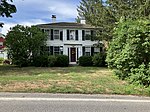Riverside Cemetery (Yarmouth, Maine)

Riverside Cemetery is a historic cemetery in Yarmouth, Maine, United States. Several prominent early business owners, sea captains and other townspeople are buried in the cemetery, including Leon Gorman, former president of L.L.Bean, which was founded by his grandfather, Leon Leonwood Bean. Although it was founded in 1869, Riverside Cemetery has graves dating to the 1700s. The cemetery's oldest burials are on the northern side; the more recent ones are on the southern side. A long driveway, which leads to another cemetery, separates the two. Of all burials at the cemetery between 2018 and 2020, 65% were burials of cremated remains.Holy Cross, a Catholic cemetery, is attached to Riverside to the east. It was established by Father Joseph Quinn, pastor of Sacred Heart Catholic Church, in the early 20th century. They both sit about 50 feet (15 m) above Yarmouth Marina, immediately to the northwest.
Excerpt from the Wikipedia article Riverside Cemetery (Yarmouth, Maine) (License: CC BY-SA 3.0, Authors, Images).Riverside Cemetery (Yarmouth, Maine)
Lafayette Street,
Geographical coordinates (GPS) Address Phone number Website Nearby Places Show on map
Geographical coordinates (GPS)
| Latitude | Longitude |
|---|---|
| N 43.793422 ° | E -70.171429 ° |
Address
Yankee Marina
Lafayette Street 142
04096
Maine, United States
Open on Google Maps










